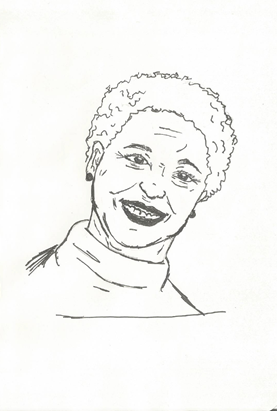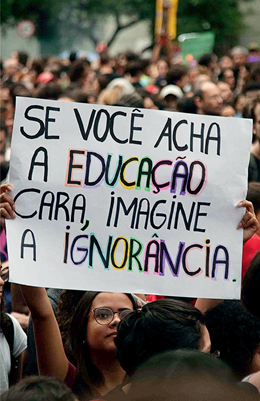by Carmen Rial
For Louis- Vincent Thomas
Translation by Jeffrey Hoff Original publication: April 14th, 2020 link
On one of my last visits to the apartment of my doctoral supervisor, the Africanist anthropologist Louis-Vincent Thomas, in the elegant Parisian neighborhood of Saint Mandé, I was stunned by the personal mode of handling death, by he who was a specialist in the theme. His apartment was lined with photographs of his wife, who had recently passed away. Literally lined, beginning from the hallway entered when stepping off of the elevator, where large banners reproduced photos from different epochs, many of them with her face, photos of augmented identity. “It’s impressive the number of photos that a person takes during their life”, he commented upon seeing my eyes fixed on them. “Just look in the drawers, and there they are”.

I was one of his last supervisees, probably the last, because he was the Doyen of the Universidade de Paris V, and only continued to supervise me because I had been with him since before he retired. Why did he supervise a thesis about cultural globalization and fast foods? In addition to the theme of death, Thomas was interested in anthropology of the future, in science fiction.
Thomas died in January 1994, less than two years after this visit. From what I remember of one of his seminars at the Sorbonne, I think that he would classify his as a “good death”: he was older than 70, and in the metro when he had a severe heart attack as he was returning from a radio or TV interview. It was with him that I learned to distinguish “good deaths”, “beautiful deaths” and “evil deaths”. More recently there has also been broad reflection on “programmed death”, euthanasia, which is increasingly present in feminist studies, for example, but I will not address this issue.
Different societies and groups elect different deaths as being beautiful, good or bad. For the ancient Greeks, Thomas taught, the ideal death, the beautiful death, would be that of a young warrior, with bow in hand, defending his city; which makes me think of the idealization of martyrs in Palestine. Among many traditional African groups, the good death is that of an old person who prepared for the event of their death, and left life surrounded by loved ones, without much suffering. In our society, a good death is a fast death, unconscious and without pain. To die with dignity would be to leave life without
passing through physical or mental degradation, without suffering or causing suffering (even if Christianity, among other religions, values physical suffering).
In many traditional societies, the worst of deaths is that which occurs far away, alone. It is considered to be very harmful to those who die and to those who remain. The cadaver has a determinant symbolic weight, it is the actor of the funerary ritual. The repatriation of bodies shows that this is still true among us, the dead body continues to be seen as central. To the contrary, the idea of an absent body, a body that is not found, can be quite upsetting to survivors. A body that has disappeared or is not identified, because of war, catastrophe or accident, produces an unsupportable void. We know this very well here in Latin America, from the supreme cruelty of the “disappearances” during the military dictatorships, where the physical liquidation of victims was not sufficient. Those who remained suffered from an absence of all references to the circumstances of death: the date, place and form. The lack of these details was like a confiscation of death, and a confiscation of the mourning of the family, leaving them blocked in a dramatic phase of denial. The official versions denied the death, transformed it into a disappearance, creating a terrible doubt about its reality. After all, the cadaver is the main element of the funerary ritual, and Thomas saw this to be universal, to the point that this reveals the fundamental essence of human consciousness.
Power and Image of Bodies
From the attack of Sept. 11 I learned that dead bodies were treated with different values by Western journalism, depending on the power of their country of origin. This difference was revealed, for example, in the mise en image of the bodies. The TV cameras, which quickly began to cover the Sept. 11 attack, initially showed people jumping out of windows from the upper stories of the burning World Trade Center. But these images were later self-censored, because they were considered too shocking to be seen by the US public and the world. This attitude continued in the following days. At
first we saw some bodies being taken from the ashes of the buildings, later, it was rare to see portrayals of wounded people or those agonizing in hospitals, or scenes of their
burials. The death of thousands of people was shown through lit candles, tears, but not in dead bodies.
The image of our dead in the Western world is shown (if they are shown) with great caution, with reserve, because it involves individuals who are seen to deserve respect. The face of a cadaver is not seen in the media. Never a naked dead body.
However, the Western media’s posture towards the dead and wounded in the Global South is quite different, especially in Muslim countries. Dead bodies are exhibited, they appear in common graves, in hospital beds, wounded, partially clothed. They are shown in close-up for a long time. This difference is perhaps best expressed in the linguistic expression coined by the US military in the Vietnam war and used to refer to civilian victims of military forces in the Afghanistan and Iraq wars: who are not called “wounded” or “dead, but referred to as “collateral damage”, in an evident objectification of human lives.
This self-censorship, or censorship, is not new; it took place during World War II when the American military displayed the bodies of the enemies, but not those of the allies. Or in more recent wars, when the bodies of US soldiers who died in combat have always been sent back in closed coffins, covered by a U.S. flag, and unloaded with pomp and circumstance by troops in full dress uniform, on red carpets, to the sound of horns.
Our bodies do not appear in images, but have their names engraved in stone, they deserve individual tombs (I am thinking of the well-groomed lawns of the cemeteries of U.S. soldiers) and monuments ( I am thinking of Ground Zero, in which the water flows over a black granite wall to a black granite pool, and from there to an even darker square from where it seems to flow to the center of the earth. The names of the 2,726 who died in the attack at the location are recorded in the granite that surrounds the pool. I think of France, where each village honors its dead from the War of 1914 with a monument to the unknown soldier.
Mourning was intense in the US for the 3 thousand who died on Sept. 11. They were honored each year, and until recently had their names read by the U.S. President at Ground Zero, and their photos were shown on TV (photos from when they were living, obviously). This is quite different from the collective graves where the bodies of the victims of the Nazi holocaust were dumped during World War II, or of the more recent “collateral damage”. It is quite different from the final destiny of the bodies of emigrants taken by the waters of the Mediterranean, 1,500 in six months of 2018 alone [1] – and here it is impossible to speak of interment, because it was an “aquament”.
The unsupportable absence of the body
How will it be now, when the most optimistic forecast is for 100,000 dead in the United States from Covid-19? What monuments will be raised in Brazil, the United States, France or India?
Covid-19 does not distinguish whether the bodies of the dead are from countries with greater or lesser power – it is a pandemic in an equalizing and global sense of the term. All are collateral damage and treated as if they were. Yes, there are extreme cases, like that of Guayaquil in Ecuador, where decaying cadavers were left in the street because the mortuary system collapsed and was incapable of handling so many bodies. In poor or wealthy countries, all are denied wakes. What will be the consequences of the absence of this ritual?
Among us, the absence of the body is only accepted when hidden in a coffin covered by a flag. Death from Covid-19, which has forced the absence of bodies, the absence of wakes, decreases the chances of a final personal contact with the dead, a last moment when the body is still on the side of life, circled by loved ones. To the contrary, we are facing fear of the cadaver, which itself is an agent of this death, and this fear will probably be unconsciously translated into an aggression in relation to the death, to a premature but protective aversion. Symbolic fantasies of contagion from the dead are now quite real.
We know that the ritual of the wake frames the disorder that death produces, circumscribes and dominates it. There is no wake for a dead body with corona virus, at least a complete wake with all its steps, in which the reality principle is left aside. To contemplate the body of the deceased, touch it, speak to it, even kiss it are moving moments of rituals at wakes that will be absent in those of Covid-19 victims. They are denied the respect of a final grooming, this ritual that seeks to remove from the cadaver the signs of death, any signs that could harm it. They pass directly from the hospital bed (if they were able to gain access to one) to a plastic bag, and from there to a coffin. Only one family member has a right to see it, to attest to the death – and there have been decrees releasing the State from this step, allowing bodies to be sent directly to a common grave.
September 11 displayed death live and in color, on a planetary scale. Covid-19 allows us to know through the website of the World Health Organization, [2] nearly in real time, through an interactive app, how many have died in each country of the globe. We have the complete statistics, their ages, morbidities – if they had heart or respiratory problems, were diabetic, if they belonged to other “risk groups”, and at times even the origin of their contamination. What we do not know is what weight these thousands of deaths without a wake will have on the subjectivities that remain. What rituals will we create? Without them, how will be bear so many deaths that are neither beautiful or good?
_____
[1] https://oglobo.globo.com/mundo/onu-alerta-que-15-mil-imigrantes-ja-morreram-no-mediterraneo-em-2018-22924119
[2] https://who.sprinklr.com/
Rial, Carmen. 2020. "Beautiful Deaths, Good Deaths, Evil Deaths, and Covid-19". Brazilian Research and Studies Blog. ISSN 2701-4924. Vol. 1 Num. 1. Available at: https://www.bras-center.com/beautiful-deaths-good-deaths-evil-deaths-and-covid-19/, accessed on: April 15, 2025.








